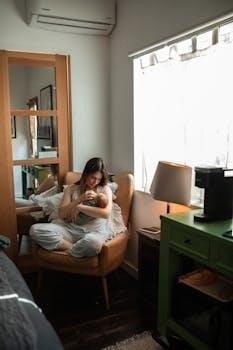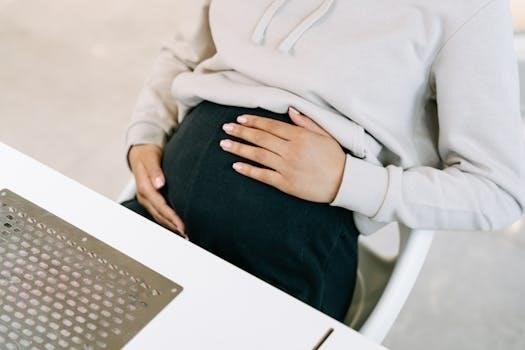
Ergonomic seating is crucial for seniors, addressing their unique needs with specialized chairs designed for comfort and safety. These chairs provide essential support and cushioning, promoting well-being and reducing discomfort for the elderly.
Understanding the Need for Specialized Chairs
As people age, their physical needs change, making standard chairs unsuitable. Specialized chairs address issues like back pain, reduced mobility, and joint discomfort commonly experienced by seniors. These orthopedic chairs provide extra support and cushioning for vulnerable areas, ensuring comfort and promoting better posture. The right chair can significantly enhance quality of life, allowing elderly individuals to sit comfortably and safely for extended periods and aiding in overall well-being.
Key Features of Orthopedic Chairs for Seniors
Orthopedic chairs for seniors offer crucial support and cushioning. Key features include adjustable armrests and footrests, promoting maximum comfort and addressing specific needs of elderly users.
Support and Cushioning for Back, Neck, and Hips
Orthopedic chairs are specifically designed to offer enhanced support for the back, neck, and hips, areas often affected by age-related issues. Adequate, high-quality padding prevents pressure points and discomfort that may occur with prolonged sitting. Cushions with molded shapes or segmented pads provide ergonomic support, promoting better posture and reducing strain for elderly individuals, making sitting more comfortable.
Adjustable Armrests and Footrests for Maximum Comfort
Adjustable armrests and footrests are key features in orthopedic chairs, allowing for personalized comfort. These adjustable components accommodate various body sizes and preferences, ensuring proper alignment and reducing strain on joints. By customizing the chair’s fit, seniors can achieve a more relaxed and supported posture, enhancing their overall comfort while sitting for extended periods. This adjustability is vital for optimal ergonomic support.
Ergonomic Design Principles in Elderly Chairs
Ergonomic design in elderly chairs focuses on proper body fit and support. These principles ensure comfortable and safe seating, addressing the unique needs of older adults with specific design considerations.
Importance of Proper Body Dimensions and Chair Fit
Considering body dimensions is crucial for optimal chair fit. A chair that doesn’t fit can cause strain and discomfort, while a well-fitted chair provides the necessary support for seniors, preventing pain. Proper seat height, depth, and width are essential for maintaining comfort and promoting good posture. Therefore, personalized fit is key to an ergonomic chair.
Addressing Issues of Mobility and Flex Positioning
Mobility limitations require chairs with features that aid movement. Flex positioning allows for various seated postures, accommodating individual needs. Chairs that offer adjustable recline or tilt functions can provide support and comfort during long periods of sitting. These features are important for enhancing comfort and ease of use for the elderly, promoting independence and well-being.

Safety Considerations in Chair Design for the Elderly
Safety is paramount when designing chairs for the elderly. Features that prevent falls and ensure stability are essential. Easy ingress and egress are also crucial for safe and comfortable use.
Preventing Falls and Ensuring Stability
Designing chairs for elderly individuals requires a strong focus on stability to prevent falls. Features like a sturdy base, non-slip materials, and a balanced design are crucial. The chair should be stable enough to prevent tipping during movement or transfers. Considering the unique needs of seniors, such as difficulties with bending or balance, is essential in creating a secure seating option that minimizes the risk of falls.
Ease of Ingress and Egress
Chair design for the elderly must prioritize easy and safe ingress and egress. The seat height should allow for comfortable transitions, avoiding the need for excessive bending or reaching. Armrests should offer support without hindering movement, while a firm seat edge can aid in getting in and out of the chair. These design elements contribute to a safer and more comfortable experience for elderly users with mobility limitations.

Specific Chair Types for Elderly Individuals
Various chair types cater to seniors’ diverse needs. Rocking chairs offer relaxation, while power lift recliners provide assistance with standing, often including heat and vibration features for added comfort.
Rocking Chairs for Relaxation and Stress Reduction
Rocking chairs are a time-honored choice for elderly individuals, providing a soothing and gentle motion that can significantly reduce stress and promote overall well-being. The rhythmic movement of a rocking chair is known to have a calming effect, which can be particularly beneficial for seniors seeking relaxation. This type of chair can create a peaceful environment, aiding in both physical and mental comfort.
Power Lift Recliners with Heat and Vibration
Power lift recliners offer exceptional assistance for elderly individuals with mobility challenges, featuring a mechanism that gently raises the chair to aid in standing. Integrated heat and vibration functions further enhance comfort and relaxation, providing therapeutic benefits for tired muscles and joint pain. These chairs often conform to ergonomic principles, ensuring optimal support and posture for the user. They are a great option for those needing extra help.
Materials and Construction of Elderly Chairs
Elderly chairs prioritize durability and lightweight design for easy movement. Padding and pressure management are crucial, often employing molded shapes or segmented pads for ergonomic comfort and support.
Durability and Lightweight Design
When selecting a chair for elderly individuals, consider the importance of both durability and a lightweight design. A robust frame is essential for long-term use, ensuring the chair can withstand daily wear and tear. Simultaneously, a lighter chair makes it easier to move, reducing the risk of strain or injury for the user and caregivers. Metal frames are often chosen for their strength and reduced weight.
Padding and Pressure Management
Adequate padding is vital in chairs for the elderly, preventing pressure points and discomfort during extended periods of sitting. High-quality padding, including molded shapes or segmented pads, offers ergonomic support and evenly distributes weight. This is especially important for older adults, who may have fragile skin or reduced mobility. Proper padding contributes significantly to overall comfort and helps avoid pain and skin issues.
Additional Features and Considerations
Beyond basic ergonomics, features like wheels for mobility and adjustable settings for personalized comfort enhance the usability and convenience of chairs designed for elderly individuals.
Wheels for Mobility
The inclusion of wheels on chairs designed for the elderly significantly enhances their mobility, allowing for easier movement within a room or around the house. This feature is particularly beneficial for those with limited strength or mobility, reducing the strain of moving a chair and promoting greater independence. Lockable wheels also provide stability when needed, preventing unwanted movement and ensuring safety.
Adjustable Features for Personalized Comfort
Adjustable features on elderly chairs are vital for providing personalized comfort, catering to individual body types and preferences. These include adjustable seat height, backrest angles, and lumbar support, allowing users to customize the chair to their specific needs. Such adjustments can alleviate pressure points, reduce discomfort, and promote better posture, making the chair more comfortable for extended use.

Office Chairs for Elderly Users
Ergonomic office chairs are essential for elderly users to avoid backaches and maintain good posture while working. These chairs should offer adjustable features for personalized comfort and support.
Ergonomic Office Chairs to Avoid Backache
For elderly individuals, ergonomic office chairs are vital in preventing back pain and promoting healthy posture. These chairs offer adjustable lumbar support, seat height, and armrests, ensuring proper alignment and reducing strain. The design should prioritize comfort and support for prolonged periods of sitting, helping seniors to maintain productivity without discomfort. Features such as breathable fabric and robust construction are also important factors to consider.
Features to Look For in an Office Chair for Seniors
When selecting an office chair for seniors, prioritize adjustable features, including seat height, lumbar support, and armrests, to ensure a personalized fit. Look for chairs with a stable base, high-quality padding, and breathable materials for added comfort. Consider a chair with a sturdy design and easy-to-operate mechanisms, along with features like swivel and casters for mobility. The chair should fit their body dimensions without strain and promote proper posture.
Research and Studies on Ergonomic Chairs
Studies explore the impact of ergonomic chairs on posture and musculoskeletal health, especially for seniors. Research guides the design of orthopedic chairs, aiming to reduce pain and improve comfort.
Studies on Posture and Musculoskeletal Disorders
Research indicates a potential link between poor seating and musculoskeletal issues, particularly in elderly populations. Studies focus on how ergonomic chairs can improve posture, alleviate back pain, and reduce the risk of disorders. These investigations often examine the relationship between chair design and comfort levels for older adults, aiming to inform better seating solutions that promote health and well-being for seniors.
Design Guidelines for Orthopedic Chairs
Orthopedic chair design must consider specific needs, focusing on proper body dimensions and adjustability for optimal comfort. Guidelines emphasize the importance of lumbar support, seat depth, and backrest height, ensuring the chair accommodates a range of body types. These chairs often incorporate features like molded cushions and segmented pads to provide pressure relief and promote proper posture, minimizing discomfort for the elderly;

Where to Find Ergonomic Chairs for Seniors
Ergonomic chairs for seniors are available through online retailers and specialized stores. Check product pages for details, options, and ensure the chair meets specific needs and preferences.
Online Retailers and Specialized Stores
Numerous online retailers offer a variety of ergonomic chairs designed for seniors, often with detailed product descriptions and customer reviews. Specialized stores, both physical and online, focus on orthopedic and ergonomic seating, providing expert advice and a range of options to consider. These sources often have different models with diverse features, ensuring a broader choice to find the most suitable chair for an elderly individual’s specific needs and comfort preferences.
Checking Product Pages for Options and Details
Product pages on retailer websites provide essential details regarding ergonomic chairs for the elderly. These pages typically include specifications, dimensions, material information, weight capacity, and adjustable features. Careful examination of these details ensures that the chair aligns with the specific requirements of the user. Checking for options like adjustable armrests, footrests, and lumbar support is crucial to finding the most comfortable and supportive chair for the elderly individual.
Choosing the right chair is vital for elderly individuals, prioritizing both comfort and safety. Ergonomic design, proper support, and adjustable features are key to enhancing their well-being and independence.
The Importance of Choosing the Right Chair for Elderly Individuals
Selecting the correct chair for elderly individuals is paramount to their health and well-being, as it directly impacts their comfort, safety, and independence. A well-chosen chair will provide appropriate support, reduce the risk of falls, and minimize discomfort from prolonged sitting. Prioritizing ergonomic design ensures that seniors can comfortably perform daily activities while maintaining proper posture and preventing musculoskeletal issues. Consider adjustable features for personalized comfort.